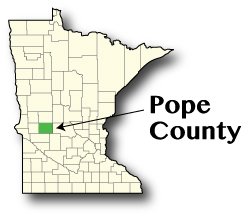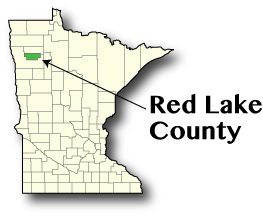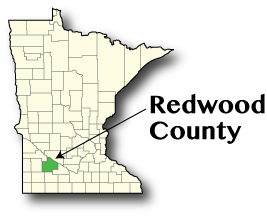by Chet Bodin
July 2018

Pope County was created on February 20, 1862, but remained an unorganized parcel of Stearns County until 1866, when it held its first election in the county seat of Glenwood. The county was named for General John Pope, whose survey expedition made its way through the area in 1849. The local culture is steeped in Scandinavian heritage, but since 2000 the minority population has more than doubled in size.
Clyde Machines, a majority woman-owned business in Glenwood, MN recently received $100,000 grant from DEED as the company moves forward with its plan to build a 100,000 square foot building. The increase in production capacity from the expansion is purported to create 15 jobs that average $14.37 an hour (mn.gov/governor/newsroom/?id=1055-343225).
Although the population of Pope County decreased in the 21st century, the number of jobs has increased by almost 13 percent since 2000. Employment gains in the county's largest industry, Manufacturing, have led the way at over 50 percent. Wages for those working in Manufacturing have also increased in Pope County by over 50 percent since 2000, but the industry is still behind Wholesale Trade in average annual wage per employee. Still, both industries paid an average wage that exceeded the cost of living for an average family living in Pope County in 2018.
| Economy | ||
|---|---|---|
| Annual Estimates | Pope County | Minnesota |
| Population | 10,970 | 5,576,606 |
| Labor Force | 6,327 | 3,063,604 |
| Average Unemployment | 3.2% | 3.6% |
| Median Household Income | $55,180 | $63,217 |
| Cost of Living, Individual | $26,493 | $31,656 |
| Cost of Living, Average Family | $45,433 | $57,624 |
| Source: 2017 DEED Local Area Unemployment Statistics; 2018 Cost of Living; 2016 American Community Survey | ||
| Industry | ||||
|---|---|---|---|---|
| Top Industries of Employment | Total 2017 Employment | Percent Change 2007-2017 | Average Annual Wages | Percent Change 2007-2017 |
| Total, All Industries | 4,367 | 12.8% | $41,823 | 39.7% |
| Manufacturing | 926 | 50.1% | $52,259 | 56.8% |
| Wholesale Trade | 615 | 10.0% | $58,095 | 11.8% |
| Retail Trade | 472 | 23.9% | $29,087 | 21.2% |
| Accommodation and Food Services | 280 | -8.8% | $13,735 | 76.4% |
| Source: DEED Quarterly Census of Employment and Wages 2006-2015 | ||||

Ramsey County, one of the first nine counties established in Minnesota in the spring of 1849, originally included all or part of Aitkin, Anoka, Hennepin, Isanti, Kanabec, Mille Lacs, Pine, Ramsey, and Washington counties. St. Paul, the county and state seat, became the transportation hub of the upper Midwest by the 1880s with its location at the head of steamboat navigation on the Mississippi River and an enormous network of rails linking the city with Chicago and the Pacific coast. Saint Paul was also one of the largest producers of beer in the nation until the Volstead Act became law in 1919, enacting prohibition. Ironically, Andrew Volstead, author and champion of the law, represented St. Paul and was a Minnesota native.
Since the legendary Ford plant closed in late 2011 after a century of operation, St. Paul has been exploring options to redevelop the site it sat on. In 2017 the city decided to rezone the site for residential development that could draw up to 4,000 new residents. The vision for the site is a connected, livable, mixed-use neighborhood that looks to the future with clean technologies and high quality design for energy, buildings, and infrastructure. This site will be woven into the existing community, and support walking, biking, and transit, and provide services, jobs, and activities that every generation can enjoy.1
Healthcare and Social Assistance is by far the largest industry of employment in Ramsey County, accounting for 19.5 percent of its total employment in 2017, and more than twice the workers as the next largest industry. However, average annual wages in healthcare were almost $12,000 less than the average of all jobs in Ramsey County, despite growing by more than 20 percent between 2007 and 2017. Median household income in Ramsey County was also less than the statewide median. Combined with a cost of living that is higher than the state average, workers in Ramsey County may struggle to meet their basic cost of living. This discrepancy is apparent despite an unemployment rate of 3.3 percent in 2017, indicating a tight labor market in the county.
| Economy | ||
|---|---|---|
| Annual Estimates | Ramsey County | Minnesota |
| Population | 547,974 | 5,576,606 |
| Labor Force | 286,523 | 3,063,604 |
| Average Unemployment | 3.3% | 3.6% |
| Median Household Income | $57,717 | $63,217 |
| Cost of Living, Individual | $33,760 | $31,656 |
| Cost of Living, Average Family | $63,457 | $57,624 |
| Source: 2017 DEED Local Area Unemployment Statistics; 2018 Cost of Living; 2016 American Community Survey | ||
| Industry | ||||
|---|---|---|---|---|
| Top Industries of Employment | Total 2017 Employment | Percent Change 2007-2017 | Average Annual Wages | Percent Change 2007-2017 |
| Total, All Industries | 331,502 | 0.1% | $62,610 | 28.8% |
| Health Care and Social Assistance | 64,554 | 23.7% | $50,783 | 20.2% |
| Manufacturing | 27,946 | -7.0% | $86,612 | 31.3% |
| Retail Trade | 27,034 | -11.0% | $31,859 | 30.3% |
| Public Administration | 26,640 | 3.5% | $67,751 | 26.9% |
| Source: DEED Quarterly Census of Employment and Wages 2006-2015 | ||||
1www.stpaul.gov/departments/planning-economic-development/planning/ford-site-21st-century-community

Although Red Lake County did not take its current form until it separated from Pennington County in 1911, the historical significance of the area dates back much further. In 1863 the Old Crossing Treaty between the U.S. and Red Lake and Pembina bands of Ojibwe opened 11 million acres of land in Northwest Minnesota and eastern North Dakota to eventual settlement. During prohibition Red Lake County was known as a hotbed of illicit moonshining and bootlegging, but the nefarious activity is also credited with lifting the county through the early part of the Great Depression. In 1956 Coya Knutson of Oklee became the first woman from the State of Minnesota to be elected to Congress where she served in the House of Representatives for two terms.
The Red Lake River watershed has been selected as a pilot area to develop One Watershed One Plan. Pilot plans will build on existing efforts, using current local water plans, state and local knowledge, and a systematic, science-based approach to watershed management. The resulting plans will address the largest threats that provide the greatest environmental benefits to each watershed. The pilot program will involve a broad range of stakeholders, including local governments, state agencies, and community members as true partners in the planning process.
Employment decreased by 14 percent in Red Lake County from 2007 to 2017, although the last year has shown a slight uptick in total jobs. In 2017 the most jobs in Red Lake County were in Educational Services, but jobs in Transportation and Warehousing paid the highest average annual wages last year. Not shown, Healthcare and Manufacturing are also important sectors in the county's economy. Although Red Lake County typically has among the highest unemployment rates in the state, it averaged 6.4 percent unemployment from 2014 – 2017, which was lower than any year before the Great Recession. In addition to notably lower unemployment, the labor force in Red Lake County increased in size since 2014, showing that jobseekers in the county are finding employment.
| Economy | ||
|---|---|---|
| Annual Estimates | Red Lake County | Minnesota |
| Population | 4,030 | 5,576,606 |
| Labor Force | 2,328 | 3,063,604 |
| Average Unemployment | 6.6% | 3.6% |
| Median Household Income | $49,800 | $63,217 |
| Cost of Living, Individual | $28,788 | $31,656 |
| Cost of Living, Average Family | $46,485 | $57,624 |
| Source: 2017 DEED Local Area Unemployment Statistics; 2018 Cost of Living; 2016 American Community Survey | ||
| Industry | ||||
|---|---|---|---|---|
| Top Industries of Employment | Total 2017 Employment | Percent Change 2007-2017 | Average Annual Wages | Percent Change 2007-2017 |
| Total, All Industries | 1,023 | -14.2% | $35,731 | 22.1% |
| Educational Services | 172 | n/a | $36,943 | n/a |
| Retail Trade | 104 | -6.3% | $27,511 | 34.5% |
| Transportation and Warehousing | 91 | 11.0% | $50,673 | 21.6% |
| Public Administration | 81 | -12.0% | $35,701 | 57.3% |
| Source: DEED Quarterly Census of Employment and Wages 2006-2015 | ||||

Redwood County began to take shape in the early 1850s, as steamboat travel made its way up the Minnesota River allowing settlers to export wheat, the first major crop produced in the area. Eventually, the Minnesota River became the county's northern border. The same year Redwood County took its name, factions of the Santee Dakota attacked the Lower Sioux Agency, or Redwood Agency, after the government failed to supply food and supplies promised in their treaty obligations. The incident led to the Dakota War of 1862, one of the most painful events in Minnesota history. In 1886 Richard W. Sears began selling watches out of the North Redwood depot, a business that would eventually become Sears, one of the largest retailers in the world and namesake for the Sears Tower in Chicago, IL.
In 2018 part of Redwood County was designated as eligible for Opportunity Zone funding from the U.S. Department of the Treasury. These funds are meant to spur investment in low-income communities facing long-term economic disparity by bridging public-private partnerships. County and state officials are emphasizing the need for workforce housing in Redwood County, a potential target for funding. The area designated in Redwood County, located just west of Redwood Falls, was one of 128 census tracts recommended by the governor as opportunity zones.
Overall, employment in Redwood County dropped by over 10 percent the past decade, yet Manufacturing thrived, growing by nearly a third since 2007. This change, coupled with a 28 percent decrease in Healthcare jobs, made Manufacturing the largest industry of employment in Redwood County last year. Despite the overall decrease in jobs, wages in Redwood County increased by over a third since 2007, including growth in each of the top four industries. This led to a median household income of $48,891 in 2016, which exceeds the cost of living for an average family there by over $4,000.
| Economy | ||
|---|---|---|
| Annual Estimates | Redwood County | Minnesota |
| Population | 15,272 | 5,576,606 |
| Labor Force | 8,332 | 3,063,604 |
| Average Unemployment | 3.9% | 3.6% |
| Median Household Income | $48,891 | $63,217 |
| Cost of Living, Individual | $26,573 | $31,656 |
| Cost of Living, Average Family | $44,509 | $57,624 |
| Source: 2017 DEED Local Area Unemployment Statistics; 2018 Cost of Living; 2016 American Community Survey | ||
| Industry | ||||
|---|---|---|---|---|
| Top Industries of Employment | Total 2017 Employment | Percent Change 2007-2017 | Average Annual Wages | Percent Change 2007-2017 |
| Total, All Industries | 6,042 | -10.8% | $36,932 | 33.8% |
| Manufacturing | 1,071 | 32.5% | $43,269 | 26.7% |
| Health Care and Social Assistance | 909 | -27.8% | $33,779 | 26.5% |
| Retail Trade | 706 | -4.5% | $24,081 | 30.9% |
| Public Administration | 579 | 28.4% | $35,216 | 36.3% |
| Source: DEED Quarterly Census of Employment and Wages 2006-2015 | ||||